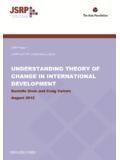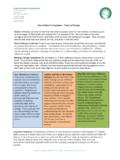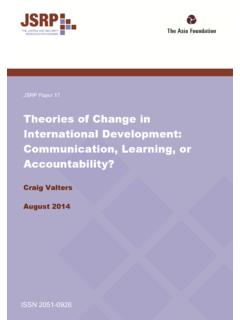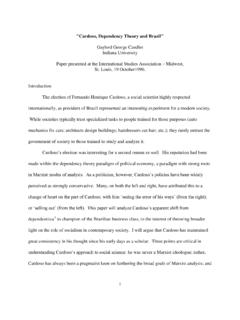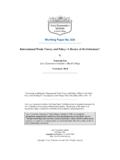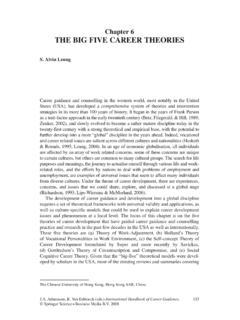Transcription of UNDERSTANDING THEORY OF CHANGE IN …
1 I JSRP Paper 1 (JSRP and TAF collaborative project) UNDERSTANDING THEORY OF CHANGE IN international development Danielle Stein and Craig Valters August 2012 ii Danielle Stein and Craig Valters, 2012 Although every effort is made to ensure the accuracy and reliability of material published in this paper, the Justice and Security Research Programme and the LSE accept no responsibility for the veracity of claims or accuracy of information provided by contributors. All rights reserved. No part of this publication may be reproduced, stored in a retrieval system, or transmitted in any form or by any means without the prior permission of the publisher, nor be issued to the public or circulated in any form other than that in which it is published. Requests for permission to reproduce any part of this paper should be sent to: The Editor, Justice and Security Research Programme, international development Department, LSE, Houghton Street, London WC2A 2AE Or by email to: 1 UNDERSTANDING THEORY OF CHANGE IN international development : A REVIEW OF EXISTING KNOWLEDGE BY DANIELLE STEIN AND CRAIG VALTERS1 Table of Contents Summary.
2 2 Methodology .. 2 What is a THEORY of CHANGE ? .. 3 The Purpose of THEORY of CHANGE .. 5 THEORY of CHANGE Levels .. 8 The Role of Key Concepts in THEORY of CHANGE .. 9 Assumptions .. 10 Evidence .. 11 Social Science THEORY .. 12 Ideas About THEORY of CHANGE Best Practice .. 13 Process .. 13 Content .. 14 Discussion .. 14 Conclusion .. 15 Key papers/Further 16 Bibliography .. 17 Annexes .. 21 1 The authors are researchers at the Justice and Security Research Programme at the London School of Economics and Political Science (LSE). Questions or comments are welcome; please send them to and Many of the key points in this literature review were developed as part of discussions within the JSRP-TAF collaboration: particular thanks go to David Lewis (LSE/JSRP), Henry Radice (JSRP), Mareike Schomerus (JSRP) and Matthew Arnold (TAF). Responsibility for this work remains with the authors.
3 2 Summary This is a review of the concepts and common debates within THEORY of CHANGE (ToC) material, resulting from a search and detailed analysis of available donor, agency and expert guidance documents. The review was undertaken as part of a Justice and Security Research Program2 (JSRP) and The Asia Foundation3 (TAF) collaborative project, and focuses on the field of international development . The project will explore the use of Theories of CHANGE (ToCs) in international development programming, with field research commencing in August 2012. While this document will specifically underpin the research of this collaboration, we also hope it will be of interest to a wider audience of those attempting to come to grips with ToC and its associated literature. From the literature, we find that there is no consensus on how to define ToC, although it is commonly understood as an articulation of how and why a given intervention will lead to specific CHANGE .
4 We identify four main purposes of ToC strategic planning, description, monitoring and evaluation and learning although these inevitably overlap. For this reason, we have adopted the term ToC approaches to identify the range of applications associated with this term. Additionally, we identify some confusion in the terminology associated with ToC. Of particular note is the lack of clarity surrounding the use of the terms assumption and evidence . Finally, we have also drawn out information on what authors feel makes for ToC best practice in terms of both content and process, alongside an exploration of the remaining gaps where more clarity is needed. A number of key issues are highlighted throughout this review. These points are an attempt to frame the literature reviewed analytically, as informed by the specific focus of the JSRP-TAF collaboration. These issues are varied and include the confusion surrounding ToC definitions and use, the need to sell a ToC to a funder, how one can know which level a ToC should operate on, the relationship between ToC and evidence-based policy, and the potential for accuracy, honesty and transparency in the use of ToC approaches.
5 This paper does not aim to give definitive answers on ToC; indeed there are many remaining important issues that lie beyond the scope of this review. However, in highlighting a number of key issues surrounding current understandings of ToC approaches, this review hopes to pave the way for more constructive and critical discussion of both the concept and practical application of ToCs. Methodology This review covers documents from major donors, development agencies and expert practitioners on ToC approaches. Of 246 documents initially accessed, 48 containing guidance or substantial discussion of ToC were The majority of documents 2 The JSRP was launched in April 2011 at the LSE international development Department. The programme involves a consortium of research partners undertaking work on issues of justice, security and governance in fragile and conflict-affected situations.
6 3 TAF is a non-profit, nongovernmental organization committed to the development of a peaceful, prosperous, just, and open Asia-Pacific region. TAF support wide-ranging programming across fragile and conflict-affected states in Asia. 4 A background document contains the full research notes of the authors for all 48 papers. It is notable that although 48 documents were reviewed to provide a measure of guidance on ToC, relatively few are 3 were obtained through a mix of systematic internet-based searches and snowballing methods. Key papers identified through personal knowledge of the research team were also included. A question template was developed to draw out information from each document and to ensure consistency across The broader findings of this paper were also informed by discussions within the JSRP-TAF collaboration, including a two-day workshop in June 2012, where the initial findings of this review were presented and debated with numerous stakeholders.
7 What is a THEORY of CHANGE ? The idea of the ToC approach seems to have first emerged in the United States in the 1990s, in the context of improving evaluation THEORY and practice in the field of community Yet the current evolution draws on two streams of development and social programme practice: evaluation and informed social practice. 7 From the evaluation perspective, ToC is part of broader program analysis or program THEORY . In the development field, it also grew out of the tradition of logic planning models such as the logical framework approach developed from the 1970s onwards. The notion of developing informed social practice has a long history; practitioners have often sought (and used) tools to attempt to consciously reflect on the underlying theories for development practice. Since their use in the field of community development , ToC approaches have increasingly become mainstream.
8 This is largely due to the demands of key funders, whose focus on ToCs has strengthened in the last few years. Though some may view ToC as simply a buzzword , it does appear that it also represents an increased desire for organisations to be able to explore and represent CHANGE in a way that reflects a complex and systemic UNDERSTANDING of This desire stems at least in part from the results agenda : ToC is seen as a way to plausibly demonstrate impact in fragile and conflict-affected regions of the world. In its early conceptualisation in 1995, Weiss described a ToC as a THEORY of how and why an initiative works. 9 More fully articulated, this can be understood as a way to describe the set of assumptions that explain both the mini-steps that lead to a long term goal and the connections between these activities and the outcomes of an intervention or ToC has been called a number of other things: a roadmap, a blueprint, an engine of CHANGE , a THEORY of action and more.
9 11 Beyond these initial conceptualisations, written solely for that purpose. Some documents cited were not fully reviewed but contained enough relevant information to be included in this paper. 5 See Annex 2 for example template. 6 For example see Weiss, (1995). Nothing as Practical as Good THEORY : Exploring THEORY -Based Evaluation for Comprehensive Community Initiatives for Children and Families. In J. Connell, A. Kubisch, L. Schorr and C. Weiss (Eds.) New Approaches to Evaluating Community Initiatives: Concepts, Methods and Contexts. New York, Aspen Institute (65-92) 7 Vogel, I. (2012). Review of the use of THEORY of CHANGE in international development . DFID, (April), p. 6. 8 James, Cathy. (2011). THEORY of CHANGE Review: A report commissioned by Comic Relief. London, p. 4. 9 Weiss (1995) 10 Anderson, A.
10 (2004). THEORY of CHANGE as a Tool for Strategic Planning: A Report on Early Experiences. The Aspen Institute: Roundtable on Community CHANGE , p. 2. 11 Reisman, Jane, Anne Gienapp, and Sarah Stachowiak (2007). A Guide to Measuring Advocacy and Policy. Organizational Research Services for the Annie E. Casey Foundation. Baltimore, Maryland (USA). 4 there is little consensus on how ToC is defined. However, like Weiss initial definition, ToC is most often defined in terms of the connection between activities and outcomes, with the articulation of this connection the key component of the ToC process. The ability to articulate this connection rests on the idea that, social programs are based on explicit or implicit theories about how and why the program will work. 12 Articulating these theories commonly involves exploring a set of beliefs or assumptions about how CHANGE will Though some consider these elements as components of ToC, others define ToCs as themselves beliefs and assumptions about Although ToCs exist in endless variations of style and content, some basic ToC components often include a big picture analysis of how CHANGE happens in relation to a specific thematic area; an articulation of an organisation or programme pathway in relation to this; and an impact assessment framework which is designed to test both the pathway and the assumptions made about how CHANGE happens.

